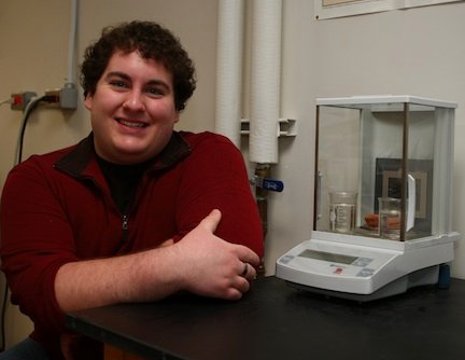A new way to date old ceramics
- On 12/01/2011
- In Conservation / Preservation
- 0 comments

By Marcia Goodrich - Michigan Tech
If you are an archaeologist, determining when a pot was made is not just a matter of checking the bottom for a time stamp. Dating clay-based materials like ceramics recovered from archeological sites can be time consuming, not to mention complex and expensive.
Patrick Bowen, a senior majoring in materials science and engineering, is refining a new way of dating ceramic artifacts that could one day shave thousands of dollars off the cost of doing archaeological research.
Called rehydroxylation dating, the technique was recently developed by researchers at the University of Manchester and the University of Edinburgh. It takes advantage of ceramics’ predictable tendency to bond chemically with water over time.
“It’s simple,” says Bowen. First, dry the sample at 105 degrees Celcius. This removes any dampness that the ceramic might have absorbed.
Then, weigh the sample and put it in a furnace at 600 degrees Celsius. The chemically bonded water, in the form of hydroxyl groups (single atoms of hydrogen and oxygen bound together), forms water vapor and evaporates. “When you do that, you mimic what the sample was like when it was originally fired,” says Bowen.
Then weigh the sample again and leave it alone. Over the next several weeks, the ceramic will react with water in the air and gain weight. Plot the gain against a time constant, and the shape of the curve tells you the age of the ceramic. Theoretically.
But it ain’t necessarily so, Bowen discovered, working with his advisors, Jaroslaw Drelich, an associate professor of materials science and engineering, and Timothy Scarlett, an associate professor of archaeology and anthropology. “The dating process turns out to be more complicated than the literature suggests,” he says.
Using shards of pottery dating from 1854 to 1888, which Scarlett provided from an archaeological dig in Utah, Bowen tried out the original dating technique at different temperatures and got significantly different “ages” for the shards.
He then developed a new equation that addresses those temperature effects, as well as the fact that rehydroxylation is actually a two-step process: First, water vapor physically penetrates the pottery. Then, it bonds chemically to the pottery’s constituent minerals.
Bowen’s equation worked better, but not well enough to generate definitive dates. Humidity fluctuations affected the samples’ weights, skewing the results. Now the research team is using new methods to provide constant humidity and will run additional tests over the next few months on various types of ceramics of different ages.
They won’t only be using rare, antique pottery this time, however. “This year we are using broken pieces of brick from the Houghton Parking Deck; it’s easier to come by,” says Bowen.
“Somebody hit it with their car, and when I saw the pieces, I thought, ‘Oh! Sample!’” If all goes as planned, each of those samples dated by Bowen and fellow researcher Tyler Botbyl, a materials science and engineering junior, will turn out to be about forty years old.
The researchers believe their work has huge potential. “This will be a new, low-cost tool allowing archaeologists to derive dates from objects made over 10,000 years of human history,” said Scarlett.
Add a comment